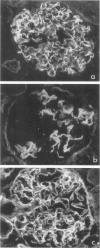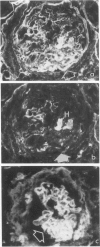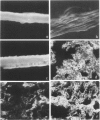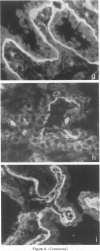Abstract
Male dogs with X-linked hereditary nephritis (HN) serve as a model for studying male patients with this disease. In the present study, carrier female dogs were found to resemble female patients in showing a broad range of renal dysfunction. Of 37 carrier female dogs studied, all were healthy up to 5 years of age; however, all had proteinuria develop at 2 to 3 months, and focal segmental glomerulosclerosis (FSGS) was detected after 7 months. After 5 years, 4 of 13 dogs remained healthy and showed mild FSGS on renal biopsy; 4 had mild renal dysfunction develop and their kidneys showed extensive FSGS; 5 died prematurely of renal failure with end-stage kidneys. By immunofluorescence, using antibody to the NC1 domain of collagen type IV, segmental staining of glomerular basement membranes (GBM) was seen in all dogs before 3 to 4 years, and lesions of FSGS were negative. Thereafter, a transition to global staining of GBM was noted and lesions of FSGS became positive. Lens capsule and basement membranes in lung and choroid plexus showed discontinuous staining in two young carrier female dogs and continuous staining in one older carrier female dog. By electron microscopy, multilaminar splitting of some GBM was seen up to 4 years, and thereafter, splitting took on a compressed appearance, with the layers becoming apposed though still detectable. The authors conclude that: 1) carrier female dogs with X-linked HN are mosaics for an abnormality in the NC1 domain of GBM and other basement membranes; 2) FSGS develops in all carrier female dogs in glomerular capillary loops that possess an abnormal NC1 domain, and progresses to a variable extent in different dogs; and 3) the abnormality of NC1 in GBM of carrier female dogs appears to diminish with age, but this does not prevent progression of renal disease. Similar conclusions may apply to females with X-linked HN.
Full text
PDF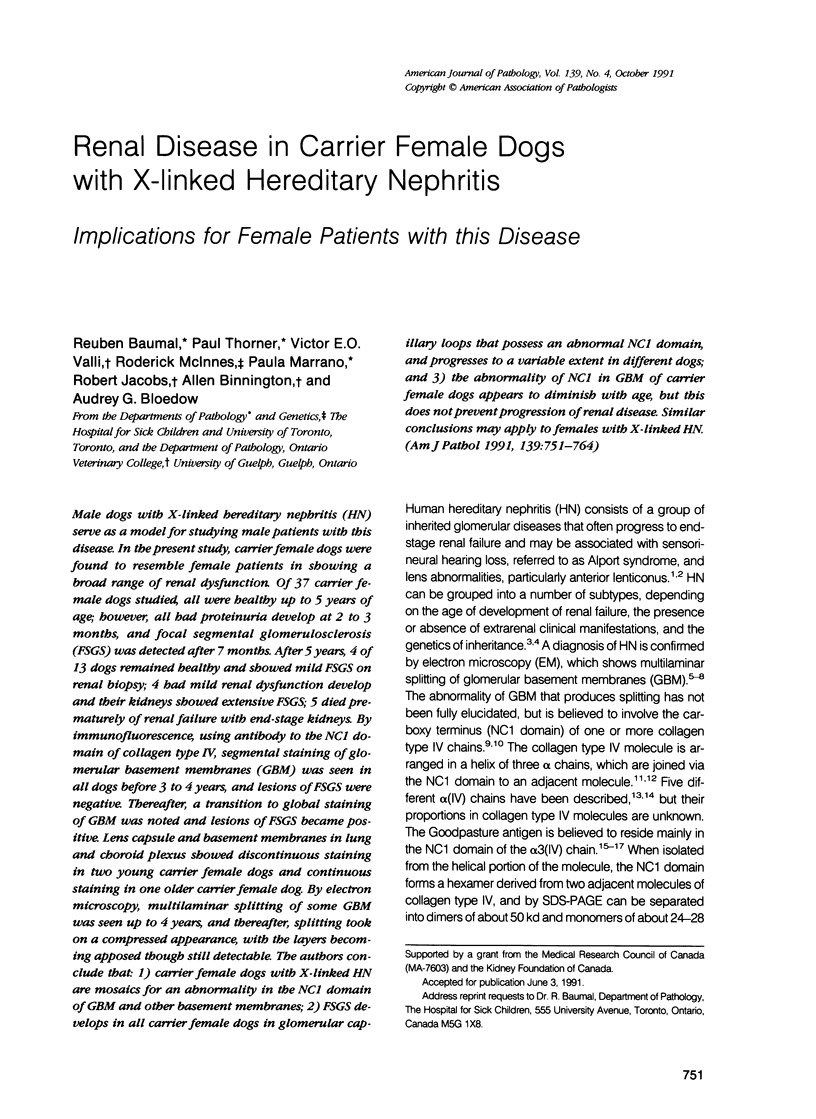
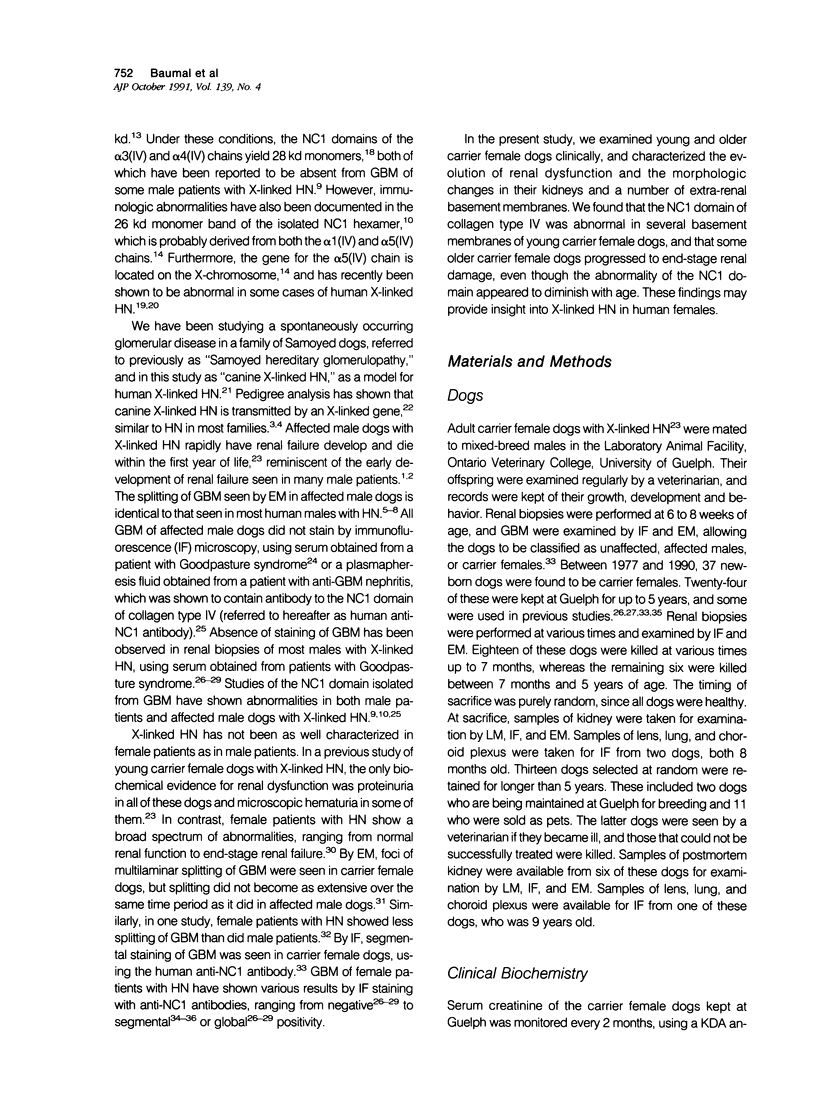
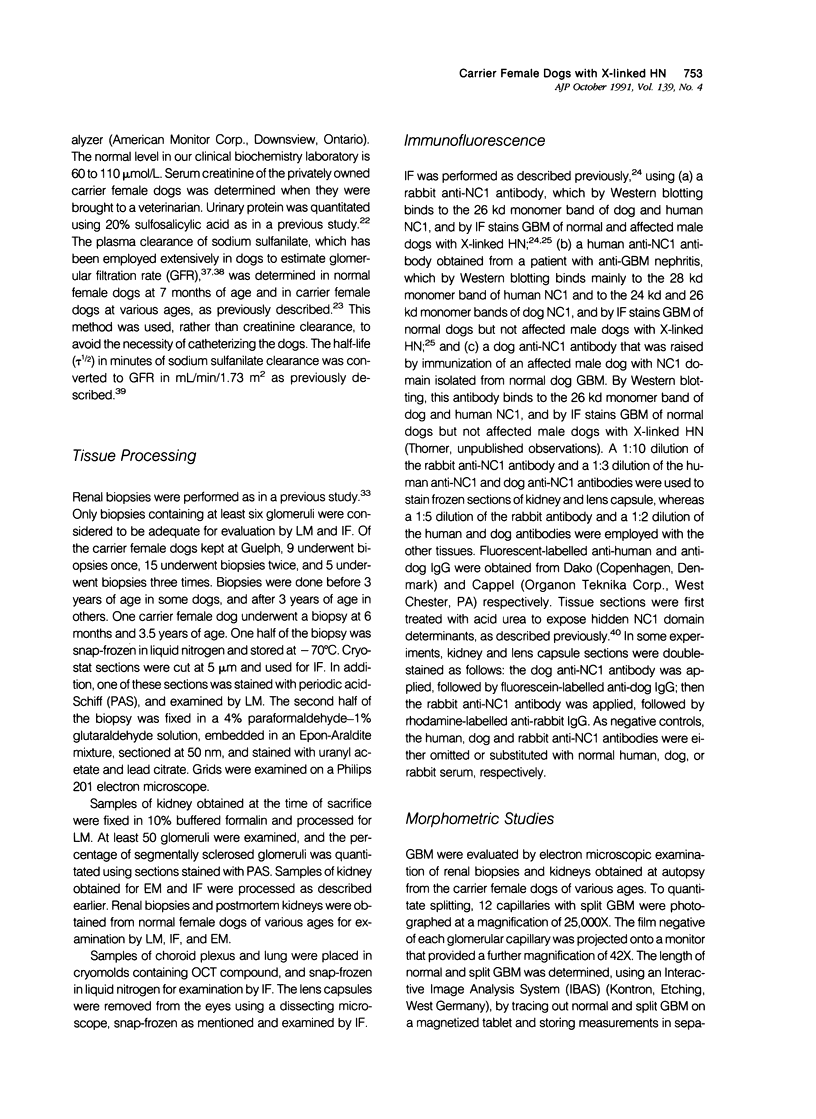
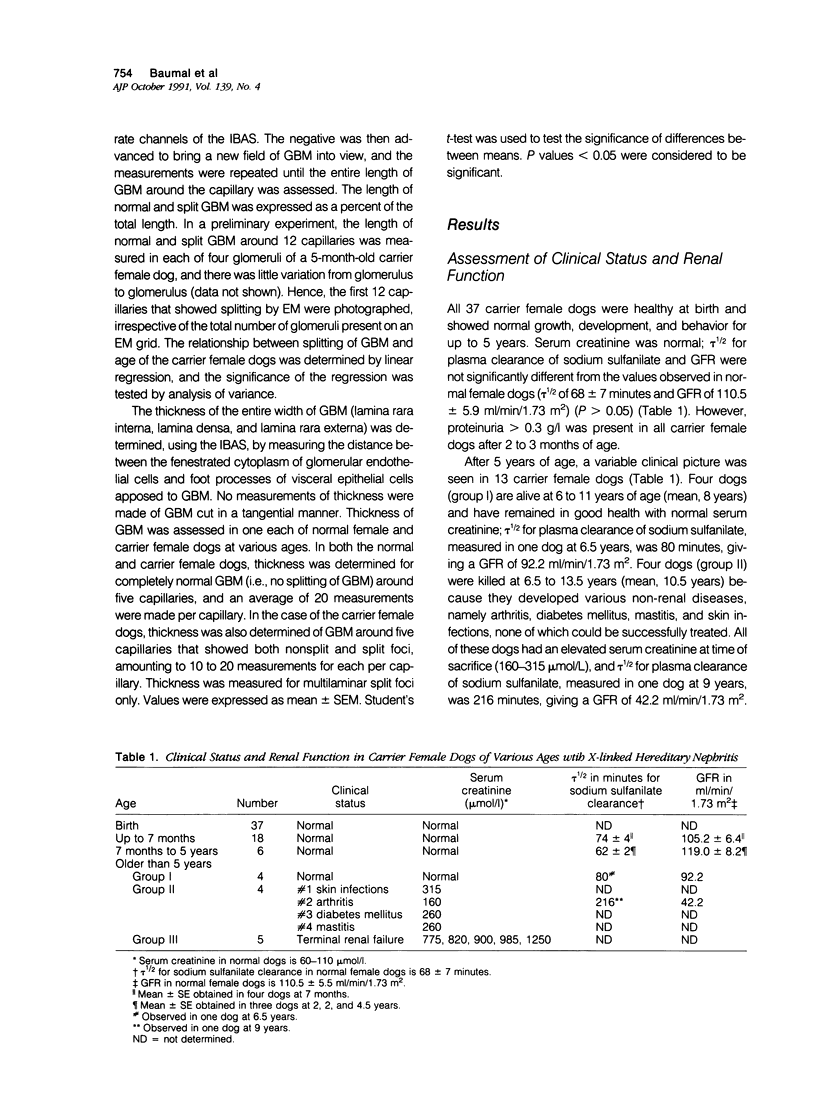
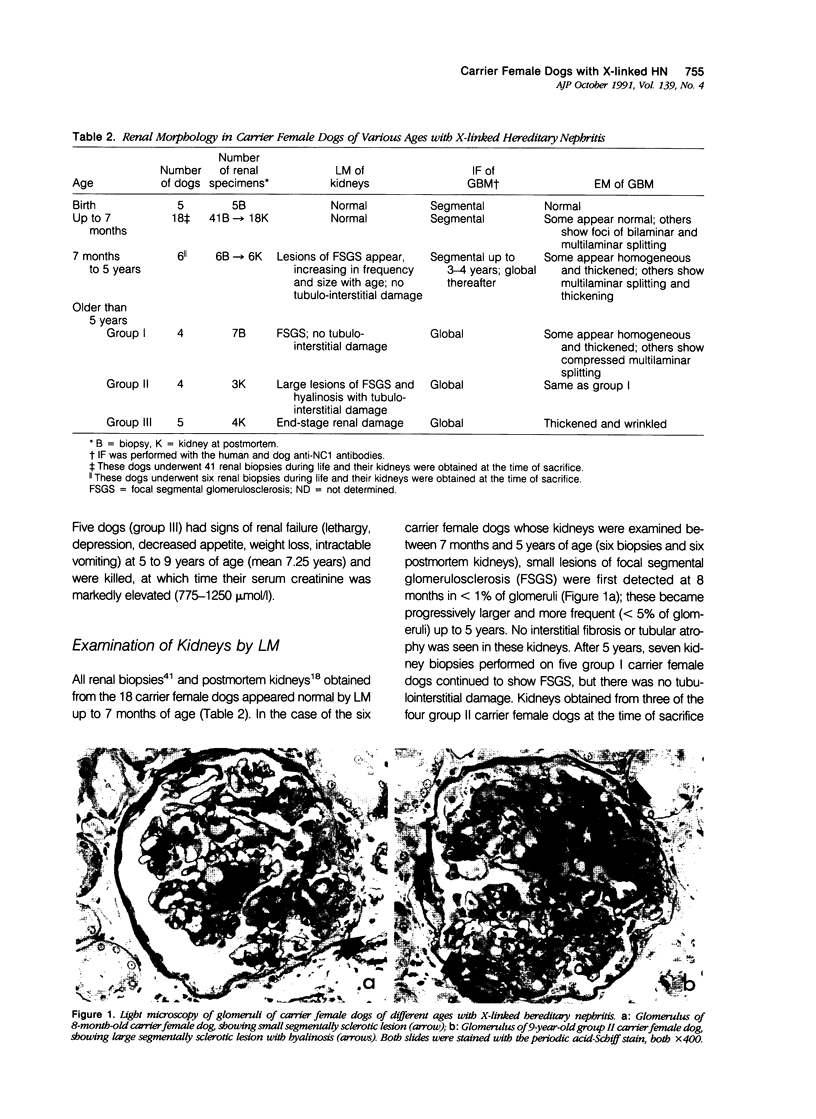
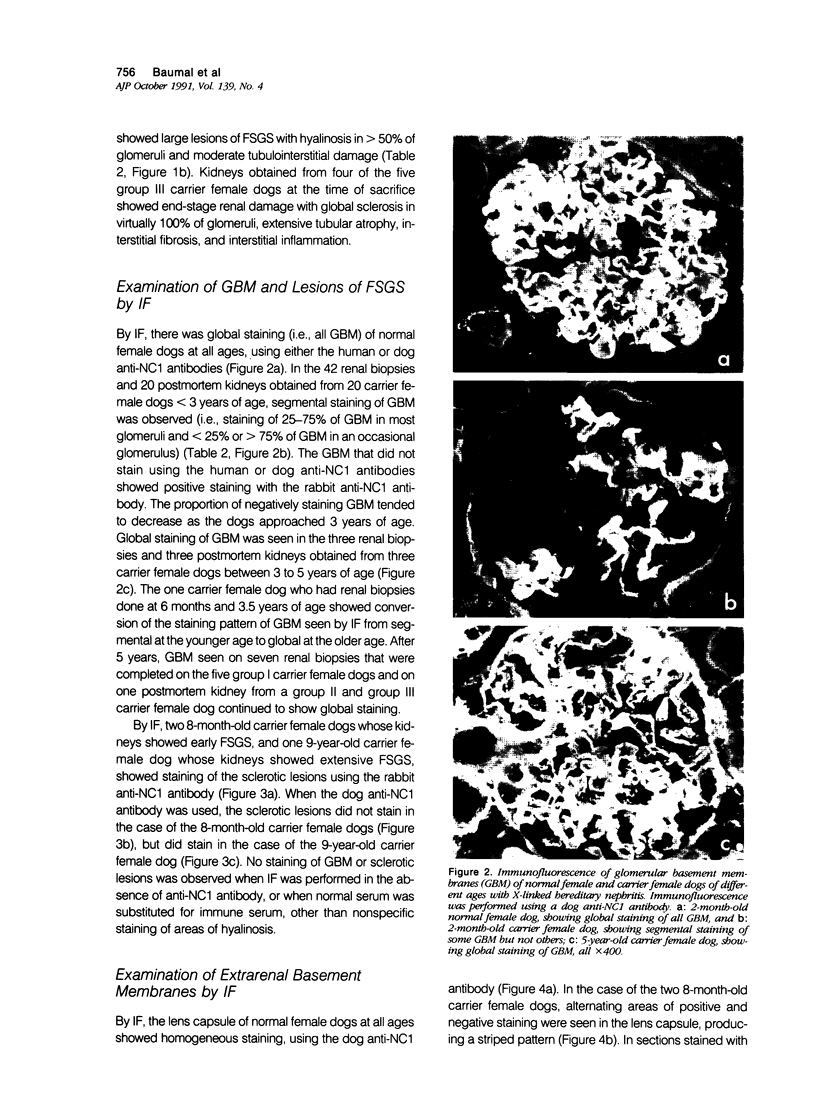
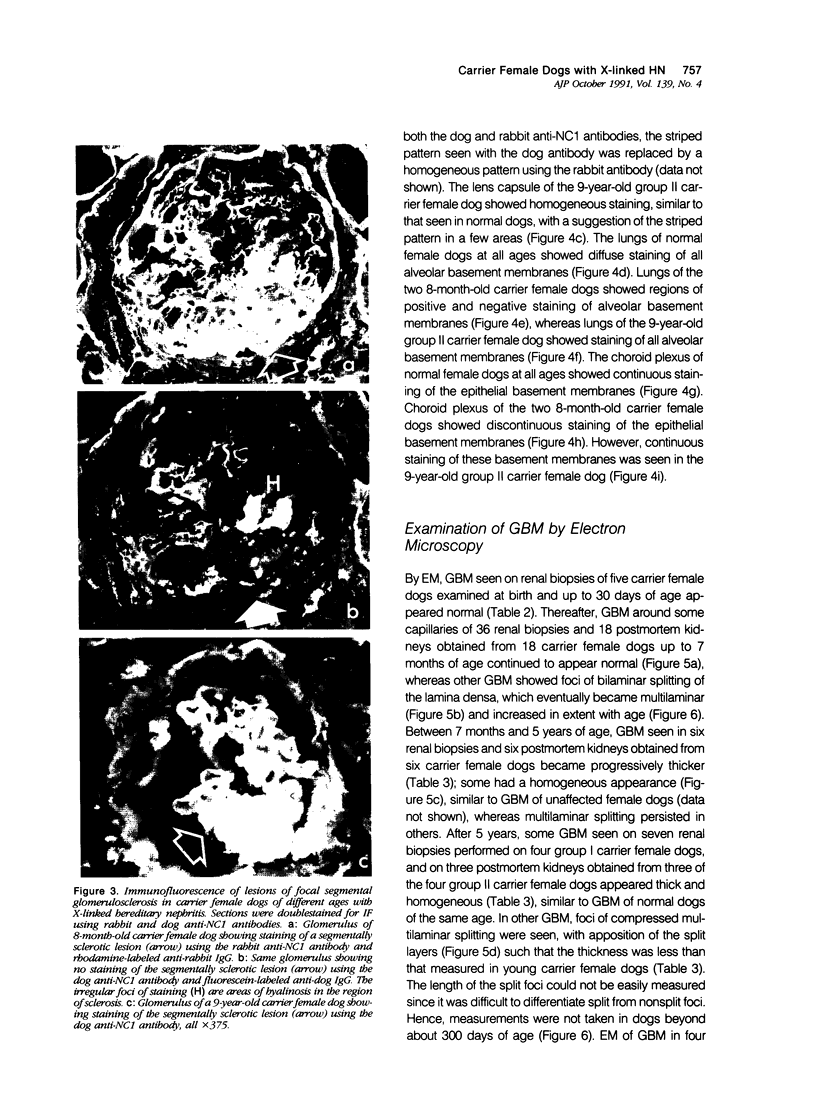
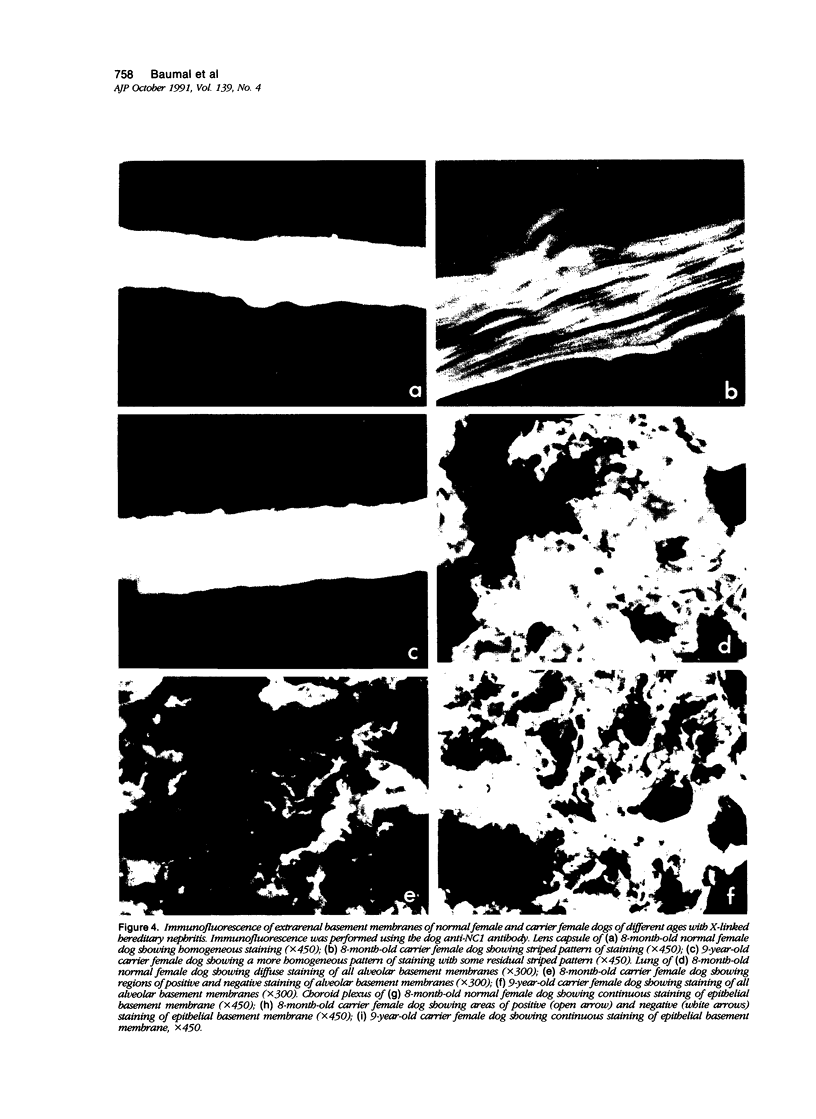
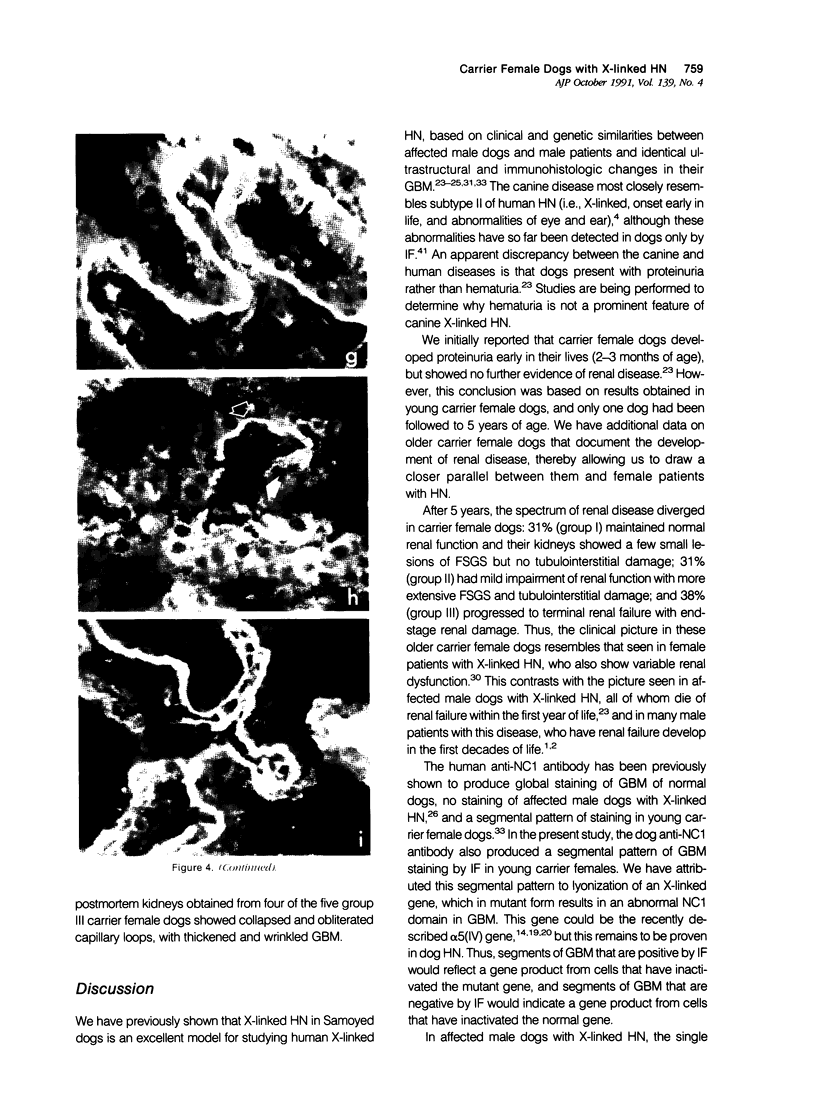
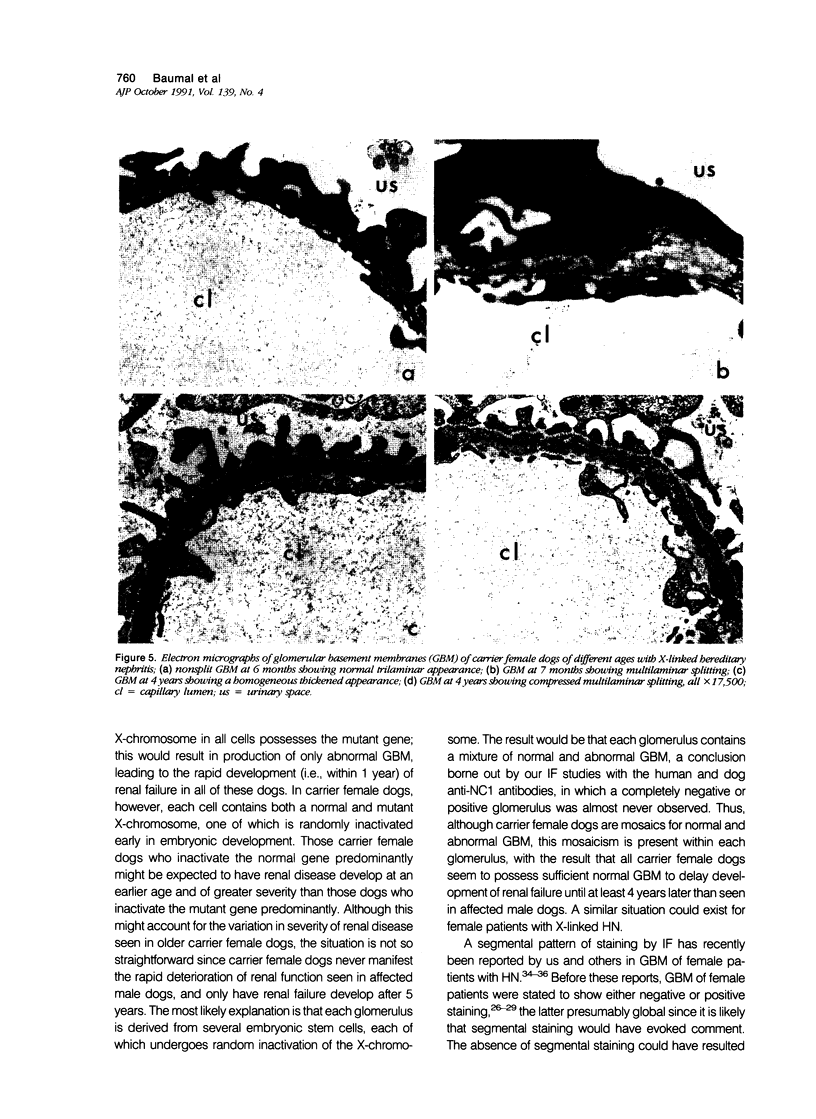
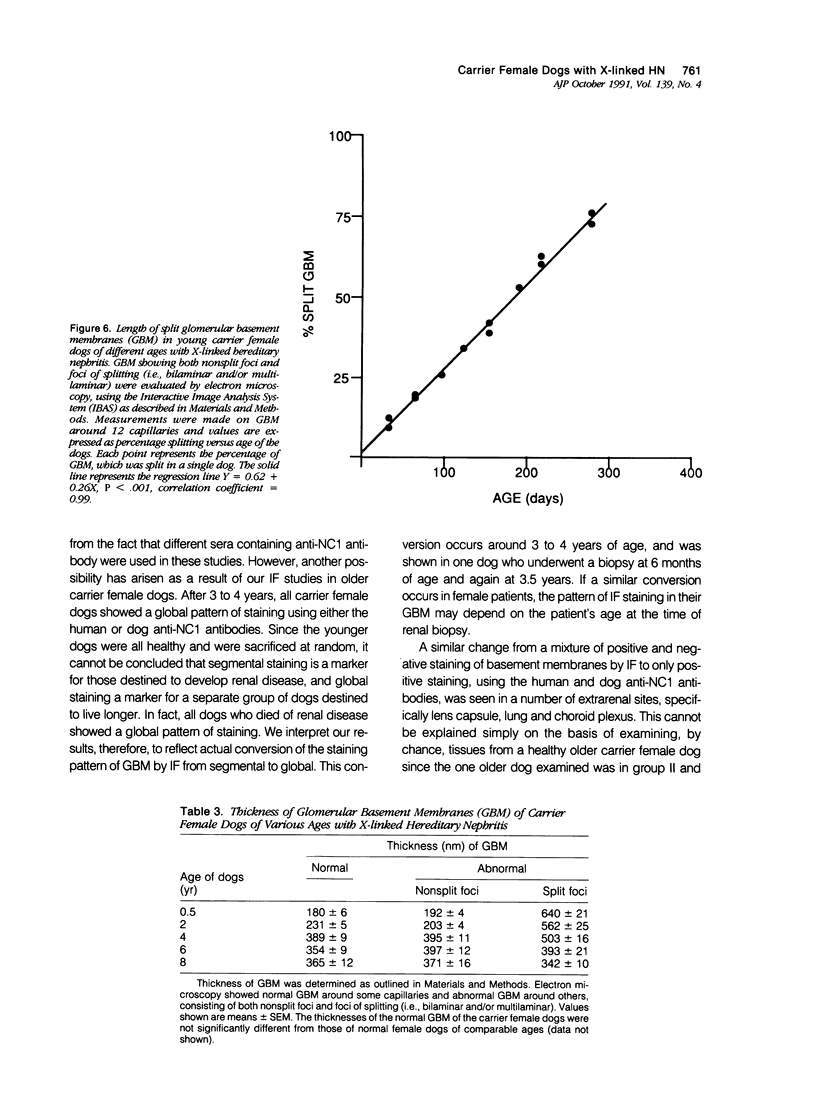
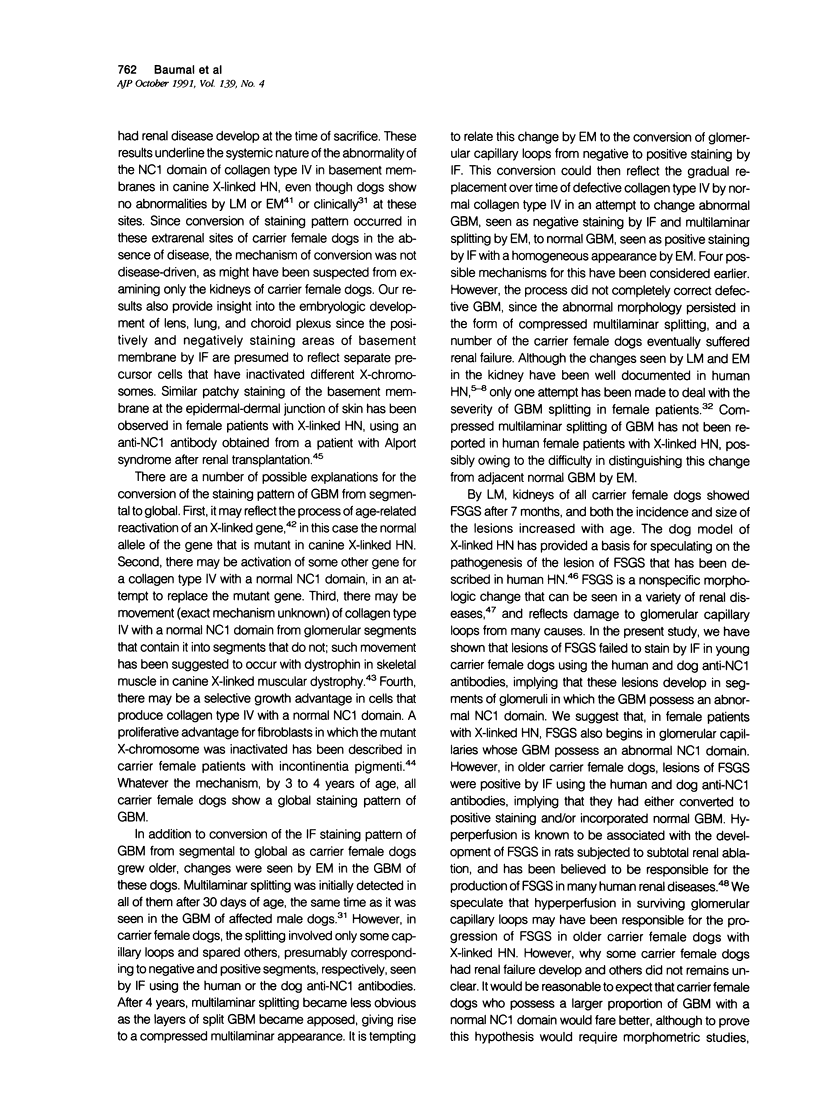
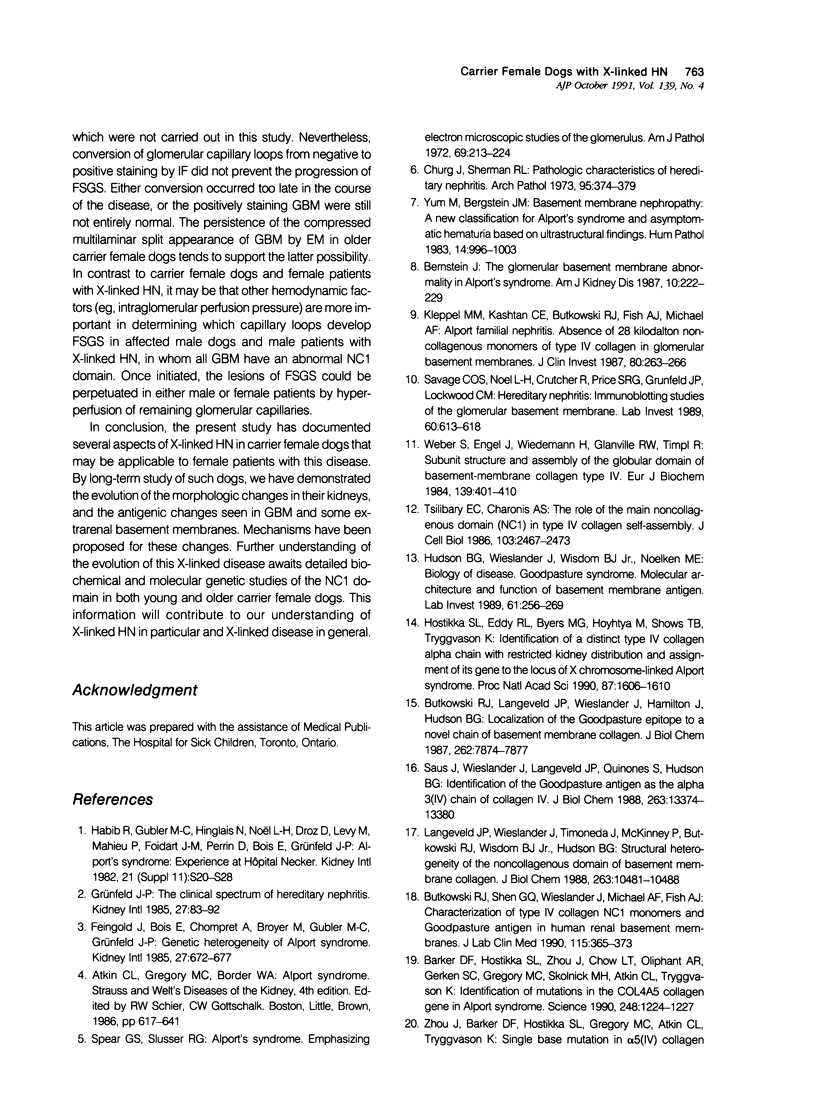
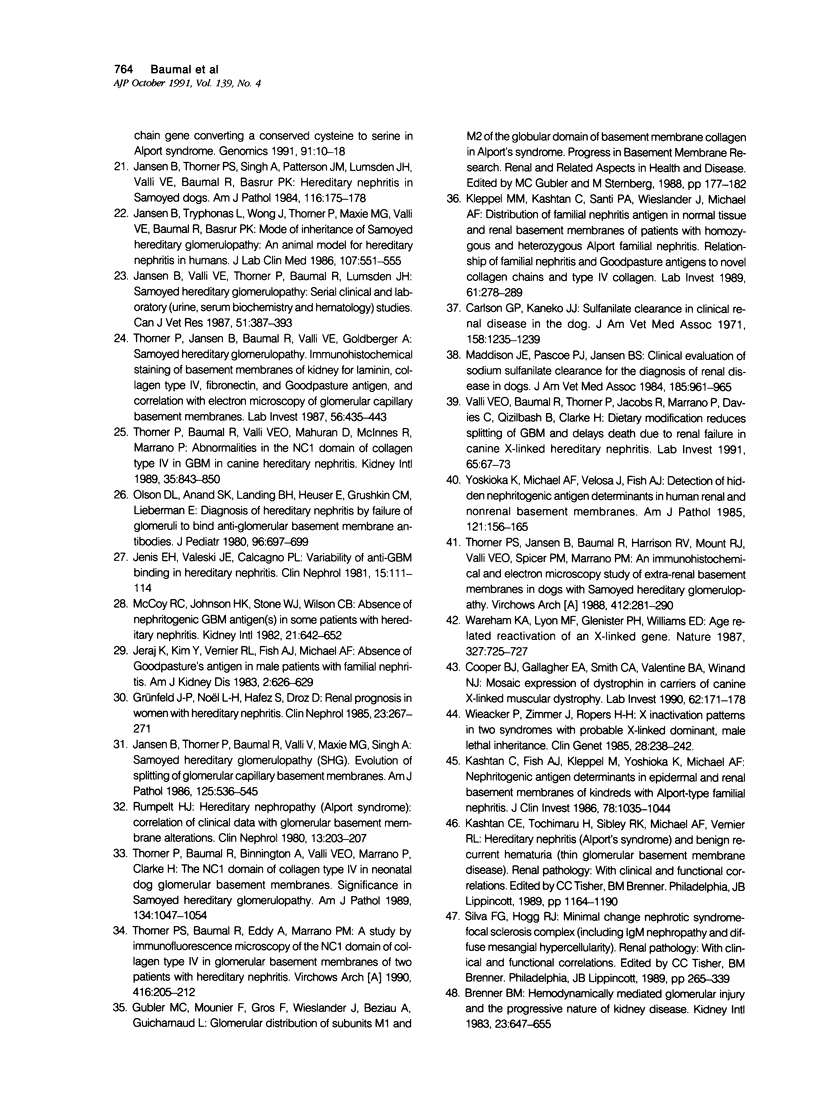
Images in this article
Selected References
These references are in PubMed. This may not be the complete list of references from this article.
- Barker D. F., Hostikka S. L., Zhou J., Chow L. T., Oliphant A. R., Gerken S. C., Gregory M. C., Skolnick M. H., Atkin C. L., Tryggvason K. Identification of mutations in the COL4A5 collagen gene in Alport syndrome. Science. 1990 Jun 8;248(4960):1224–1227. doi: 10.1126/science.2349482. [DOI] [PubMed] [Google Scholar]
- Bernstein J. The glomerular basement membrane abnormality in Alport's syndrome. Am J Kidney Dis. 1987 Sep;10(3):222–229. doi: 10.1016/s0272-6386(87)80177-4. [DOI] [PubMed] [Google Scholar]
- Brenner B. M. Hemodynamically mediated glomerular injury and the progressive nature of kidney disease. Kidney Int. 1983 Apr;23(4):647–655. doi: 10.1038/ki.1983.72. [DOI] [PubMed] [Google Scholar]
- Butkowski R. J., Langeveld J. P., Wieslander J., Hamilton J., Hudson B. G. Localization of the Goodpasture epitope to a novel chain of basement membrane collagen. J Biol Chem. 1987 Jun 5;262(16):7874–7877. [PubMed] [Google Scholar]
- Butkowski R. J., Shen G. Q., Wieslander J., Michael A. F., Fish A. J. Characterization of type IV collagen NC1 monomers and Goodpasture antigen in human renal basement membranes. J Lab Clin Med. 1990 Mar;115(3):365–373. [PubMed] [Google Scholar]
- Carlson G. P., Kaneko J. J. Sulfanilate clearance in clinical renal disease in the dog. J Am Vet Med Assoc. 1971 Apr 1;158(7):1235–1239. [PubMed] [Google Scholar]
- Churg J., Sherman R. L. Pathologic characteristics of hereditary nephritis. Arch Pathol. 1973 Jun;95(6):374–379. [PubMed] [Google Scholar]
- Cooper B. J., Gallagher E. A., Smith C. A., Valentine B. A., Winand N. J. Mosaic expression of dystrophin in carriers of canine X-linked muscular dystrophy. Lab Invest. 1990 Feb;62(2):171–178. [PubMed] [Google Scholar]
- Feingold J., Bois E., Chompret A., Broyer M., Gubler M. C., Grünfeld J. P. Genetic heterogeneity of Alport syndrome. Kidney Int. 1985 Apr;27(4):672–677. doi: 10.1038/ki.1985.63. [DOI] [PubMed] [Google Scholar]
- Grünfeld J. P., Noël L. H., Hafez S., Droz D. Renal prognosis in women with hereditary nephritis. Clin Nephrol. 1985 Jun;23(6):267–271. [PubMed] [Google Scholar]
- Grünfeld J. P. The clinical spectrum of hereditary nephritis. Kidney Int. 1985 Jan;27(1):83–92. doi: 10.1038/ki.1985.14. [DOI] [PubMed] [Google Scholar]
- Habib R., Gubler M. C., Hinglais N., Noël L. H., Droz D., Levy M., Mahieu P., Foidart J. M., Perrin D., Bois E. Alport's syndrome: experience at Hôpital Necker. Kidney Int Suppl. 1982 May;11:S20–S28. [PubMed] [Google Scholar]
- Hostikka S. L., Eddy R. L., Byers M. G., Höyhtyä M., Shows T. B., Tryggvason K. Identification of a distinct type IV collagen alpha chain with restricted kidney distribution and assignment of its gene to the locus of X chromosome-linked Alport syndrome. Proc Natl Acad Sci U S A. 1990 Feb;87(4):1606–1610. doi: 10.1073/pnas.87.4.1606. [DOI] [PMC free article] [PubMed] [Google Scholar]
- Hudson B. G., Wieslander J., Wisdom B. J., Jr, Noelken M. E. Goodpasture syndrome: molecular architecture and function of basement membrane antigen. Lab Invest. 1989 Sep;61(3):256–269. [PubMed] [Google Scholar]
- Jansen B., Thorner P. S., Singh A., Patterson J. M., Lumsden J. H., Valli V. E., Baumal R., Basrur R. K. Animal model of human disease: hereditary nephritis in Samoyed dogs. Am J Pathol. 1984 Jul;116(1):175–178. [PMC free article] [PubMed] [Google Scholar]
- Jansen B., Thorner P., Baumal R., Valli V., Maxie M. G., Singh A. Samoyed hereditary glomerulopathy (SHG). Evolution of splitting of glomerular capillary basement membranes. Am J Pathol. 1986 Dec;125(3):536–545. [PMC free article] [PubMed] [Google Scholar]
- Jansen B., Tryphonas L., Wong J., Thorner P., Maxie M. G., Valli V. E., Baumal R., Basrur P. K. Mode of inheritance of Samoyed hereditary glomerulopathy: an animal model for hereditary nephritis in humans. J Lab Clin Med. 1986 Jun;107(6):551–555. [PubMed] [Google Scholar]
- Jansen B., Valli V. E., Thorner P., Baumal R., Lumsden J. H. Samoyed hereditary glomerulopathy: serial, clinical and laboratory (urine, serum biochemistry and hematology) studies. Can J Vet Res. 1987 Jul;51(3):387–393. [PMC free article] [PubMed] [Google Scholar]
- Jenis E. H., Valeski J. E., Calcagno P. L. Variability of anti-GBM binding in hereditary nephritis. Clin Nephrol. 1981 Mar;15(3):111–114. [PubMed] [Google Scholar]
- Jeraj K., Kim Y., Vernier R. L., Fish A. J., Michael A. F. Absence of Goodpasture's antigen in male patients with familial nephritis. Am J Kidney Dis. 1983 May;2(6):626–629. doi: 10.1016/s0272-6386(83)80043-2. [DOI] [PubMed] [Google Scholar]
- Kashtan C., Fish A. J., Kleppel M., Yoshioka K., Michael A. F. Nephritogenic antigen determinants in epidermal and renal basement membranes of kindreds with Alport-type familial nephritis. J Clin Invest. 1986 Oct;78(4):1035–1044. doi: 10.1172/JCI112658. [DOI] [PMC free article] [PubMed] [Google Scholar]
- Kleppel M. M., Kashtan C. E., Butkowski R. J., Fish A. J., Michael A. F. Alport familial nephritis. Absence of 28 kilodalton non-collagenous monomers of type IV collagen in glomerular basement membrane. J Clin Invest. 1987 Jul;80(1):263–266. doi: 10.1172/JCI113057. [DOI] [PMC free article] [PubMed] [Google Scholar]
- Kleppel M. M., Kashtan C., Santi P. A., Wieslander J., Michael A. F. Distribution of familial nephritis antigen in normal tissue and renal basement membranes of patients with homozygous and heterozygous Alport familial nephritis. Relationship of familial nephritis and Goodpasture antigens to novel collagen chains and type IV collagen. Lab Invest. 1989 Sep;61(3):278–289. [PubMed] [Google Scholar]
- Langeveld J. P., Wieslander J., Timoneda J., McKinney P., Butkowski R. J., Wisdom B. J., Jr, Hudson B. G. Structural heterogeneity of the noncollagenous domain of basement membrane collagen. J Biol Chem. 1988 Jul 25;263(21):10481–10488. [PubMed] [Google Scholar]
- Maddison J. E., Pascoe P. J., Jansen B. S. Clinical evaluation of sodium sulfanilate clearance for the diagnosis of renal disease in dogs. J Am Vet Med Assoc. 1984 Nov 1;185(9):961–965. [PubMed] [Google Scholar]
- McCoy R. C., Johnson H. K., Stone W. J., Wilson C. B. Absence of nephritogenic GBM antigen(s) in some patients with hereditary nephritis. Kidney Int. 1982 Apr;21(4):642–652. doi: 10.1038/ki.1982.72. [DOI] [PubMed] [Google Scholar]
- Olson D. L., Anand S. K., Landing B. H., Heuser E., Grushkin C. M., Lieberman E. Diagnosis of hereditary nephritis by failure of glomeruli to bind anti-glomerular basement membrane antibodies. J Pediatr. 1980 Apr;96(4):697–699. doi: 10.1016/s0022-3476(80)80746-3. [DOI] [PubMed] [Google Scholar]
- Rumpelt H. J. Hereditary nephropathy (Alport syndrome): correlation of clinical data with glomerular basement membrane alterations. Clin Nephrol. 1980 May;13(5):203–207. [PubMed] [Google Scholar]
- Saus J., Wieslander J., Langeveld J. P., Quinones S., Hudson B. G. Identification of the Goodpasture antigen as the alpha 3(IV) chain of collagen IV. J Biol Chem. 1988 Sep 15;263(26):13374–13380. [PubMed] [Google Scholar]
- Savage C. O., Noel L. H., Crutcher E., Price S. R., Grunfeld J. P., Lockwood C. M. Hereditary nephritis: immunoblotting studies of the glomerular basement membrane. Lab Invest. 1989 May;60(5):613–618. [PubMed] [Google Scholar]
- Spear G. S., Slusser R. J. Alport's syndrome. Emphasizing electron microscopic studies of the glomerulus. Am J Pathol. 1972 Nov;69(2):213–224. [PMC free article] [PubMed] [Google Scholar]
- Thorner P. S., Baumal R., Eddy A., Marrano P. M. A study by immunofluorescence microscopy of the NC1 domain of collagen type IV in glomerular basement membranes of two patients with hereditary nephritis. Virchows Arch A Pathol Anat Histopathol. 1990;416(3):205–212. doi: 10.1007/BF01678979. [DOI] [PubMed] [Google Scholar]
- Thorner P. S., Jansen B., Baumal R., Harrison R. V., Mount R. J., Valli V. E., Spicer P. M., Marrano P. M. An immunohistochemical and electron microscopic study of extra-renal basement membranes in dogs with Samoyed hereditary glomerulopathy. Virchows Arch A Pathol Anat Histopathol. 1988;412(3):281–290. doi: 10.1007/BF00737153. [DOI] [PubMed] [Google Scholar]
- Thorner P., Baumal R., Binnington A., Valli V. E., Marrano P., Clarke H. The NC1 domain of collagen type IV in neonatal dog glomerular basement membranes. Significance in Samoyed hereditary glomerulopathy. Am J Pathol. 1989 May;134(5):1047–1054. [PMC free article] [PubMed] [Google Scholar]
- Thorner P., Baumal R., Valli V. E., Mahuran D., McInnes R., Marrano P. Abnormalities in the NC1 domain of collagen type IV in GBM in canine hereditary nephritis. Kidney Int. 1989 Mar;35(3):843–850. doi: 10.1038/ki.1989.62. [DOI] [PubMed] [Google Scholar]
- Thorner P., Jansen B., Baumal R., Valli V. E., Goldberger A. Samoyed hereditary glomerulopathy. Immunohistochemical staining of basement membranes of kidney for laminin, collagen type IV, fibronectin, and Goodpasture antigen, and correlation with electron microscopy of glomerular capillary basement membranes. Lab Invest. 1987 Apr;56(4):435–443. [PubMed] [Google Scholar]
- Tsilibary E. C., Charonis A. S. The role of the main noncollagenous domain (NC1) in type IV collagen self-assembly. J Cell Biol. 1986 Dec;103(6 Pt 1):2467–2473. doi: 10.1083/jcb.103.6.2467. [DOI] [PMC free article] [PubMed] [Google Scholar]
- Valli V. E., Baumal R., Thorner P., Jacobs R., Marrano P., Davies C., Qizilbash B., Clarke H. Dietary modification reduces splitting of glomerular basement membranes and delays death due to renal failure in canine X-linked hereditary nephritis. Lab Invest. 1991 Jul;65(1):67–73. [PubMed] [Google Scholar]
- Wareham K. A., Lyon M. F., Glenister P. H., Williams E. D. Age related reactivation of an X-linked gene. 1987 Jun 25-Jul 1Nature. 327(6124):725–727. doi: 10.1038/327725a0. [DOI] [PubMed] [Google Scholar]
- Weber S., Engel J., Wiedemann H., Glanville R. W., Timpl R. Subunit structure and assembly of the globular domain of basement-membrane collagen type IV. Eur J Biochem. 1984 Mar 1;139(2):401–410. doi: 10.1111/j.1432-1033.1984.tb08019.x. [DOI] [PubMed] [Google Scholar]
- Wieacker P., Zimmer J., Ropers H. H. X inactivation patterns in two syndromes with probable X-linked dominant, male lethal inheritance. Clin Genet. 1985 Sep;28(3):238–242. doi: 10.1111/j.1399-0004.1985.tb00392.x. [DOI] [PubMed] [Google Scholar]
- Yoshioka K., Michael A. F., Velosa J., Fish A. J. Detection of hidden nephritogenic antigen determinants in human renal and nonrenal basement membranes. Am J Pathol. 1985 Oct;121(1):156–165. [PMC free article] [PubMed] [Google Scholar]
- Yum M., Bergstein J. M. Basement membrane nephropathy: a new classification for Alport's syndrome and asymptomatic hematuria based on ultrastructural findings. Hum Pathol. 1983 Nov;14(11):996–1003. doi: 10.1016/s0046-8177(83)80180-4. [DOI] [PubMed] [Google Scholar]




